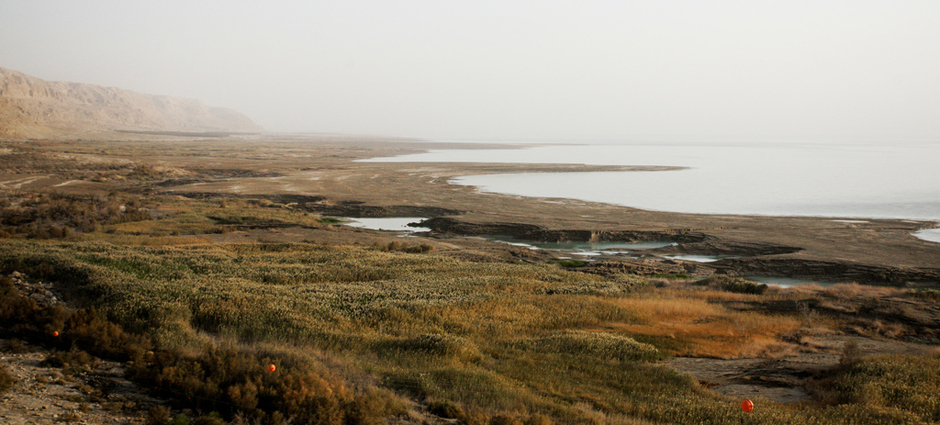
A few years ago, I was walking on water in Israel, when I had what seemed like a powerful — and badly needed — revelation about healing. Earlier that day, as part of a press tour of luxury spas in the Holy Land, our group had taken a side trip to the legendary mountaintop fortress at Masada. I was feeling claustrophobic from the bus ride, so I decided to run up the old trail to the fortress rather than ride up in the gondola. It was 1,300 vertical feet, and I didn’t stop to get a hat or water bottle. I just charged upward, leaping from rock to rock in the desert sun. Along the way I noticed that I’d stopped sweating. What I didn’t notice was the damage I was doing to my right knee. I got to the top feeling triumphant, sat down, and could barely get up again. I hobbled through the tour of the fortress, rode the gondola back to the bus, and we drove to the Holiday Inn Crowne Plaza Dead Sea Spa.
I felt exhausted and hurt and exceedingly stupid. But I knew that people had been coming to the Dead Sea for healing since Biblical times, so I pulled on my bathing suit and limped across the white, salt-crystal beach into the water. I kept walking, straight out, and pretty soon I no longer felt the salt crystals underfoot. That’s when I realized two marvelous things: I was walking on water (albeit chest deep) and my knee had stopped hurting.
Here I was wrapped for free in hot mud prized by Roman emperors, and I was estimating how much money I would gladly pay someone to please get me out of there.
To walk on the fresh water of the nearby Sea of Galilee takes a miracle, but here the salt is so thick that anyone can do it. I jogged and danced, pain-free, feeling as if I myself had walked into a Biblical healing story. But then I walked back out, hit the beach, and realized that my knee still hurt like hell. So much for that.
An hour or so later, I was lying on a large sheet of plastic in a small room in the hotel spa, while a powerful Russian woman slathered my body with hot mud. Once I was completely basted, she wrapped the plastic as well several layers of heavy blankets around me, so that the only things capable of movement were my thoughts — which went something like this: I should feel exceedingly grateful for this press trip. Spectacular places, remarkable food, exotic treatments — and all of it gratis! But maybe I should feel guilty. I’m a journalist. How can I objectively evaluate these often wildly expensive experiences that I haven’t paid for?
Mostly I was feeling a sense of irony. Here I was wrapped for free in hot mud that had been prized by Roman emperors, and I was estimating how much money I would gladly pay someone to please get me out of there.
After I had been unwrapped and unceremoniously hosed off by the Russian woman, I headed up the marble stairs, relieved that it was over. Then I abruptly stopped. I shook my leg tentatively. I hopped gently. Then I leaped upward. “Oh my God!” I said aloud. My knee was healed! I suddenly and viscerally understood why ancient baths and spas were regarded as sacred places for healing. I also understood how the spa industry developed from those sacred spaces. In fact, I found myself in the gift shop stocking up on local skin creams and wishing I could bring home enough Dead Sea mud to fill a hot tub.
Stephen Kiesling
Stephen Kiesling is a writer and editor whose career was launched in 1982 with the classic rowing book The Shell Game and The New York Times Book Review, “Just as it is good that there was a riverboat pilot who could write…it is good that there is one true blue jock who can.” A Scholar of the House in philosophy at Yale, Stephen was a 1980 Olympic oarsman who also raced in the 2008 Olympic Trials. He learned journalism from T George Harris, a decorated World War II artillery scout and Time reporter who created Psychology Today. T George and Stephen launched both American Health magazine and Spirituality & Health, where Stephen continues as Editor at Large. He has written for the New Yorker, Sports Illustrated and Outside, was a spokesman for Nike, started a celebrated rowing club, and has built parks and playgrounds. He lives at Ti’lomikh Falls on the Rogue River in southern Oregon, where he writes for his wife Mary Bemis at Insidersguidetospas.com. Stephen is also the caretaker of one of America’s oldest Salmon Ceremonies and is working on a whitewater park and sculpture garden. He is interested in transformational retreats, anything to do with water, the Native American origins of our democracy, and the process of becoming what he calls an Earth-Indigenous Elder, a person who knows their own story from the beginning of time.